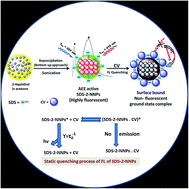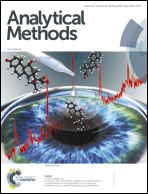AIEE active SDS stabilized 2-naphthol nanoparticles as a novel fluorescent sensor for the selective recognition of crystal violet: application to environmental analysis
Abstract
Fluorescent nanoparticles of sodium dodecyl sulphate stabilized 2-naphthol (SDS-2-NNPs) were prepared using a reprecipitation method, and exhibited aggregation-induced enhanced emission (AIEE) at 410 nm. A novel spectrofluorimetric method for the quantitative determination of crystal violet based on the fluorescence quenching of SDS-2-NNPs in aqueous solution was proposed. The FL (fluorescence) intensity of SDS-2-NNPs, monitored at an excitation wavelength of 297 nm, was quenched by the successive addition of increasing amounts of crystal violet solution. The quenching results were found to fit the Stern–Volmer relationship in the range of 0.1–40 μg L−1, with a correlation coefficient of 0.9990. The limit of detection was found to be 0.38 ng L−1. The proposed sensing method based on FL quenching can be successfully applied for the quantitative analysis of crystal violet, over competitive ions, in water samples collected from different environments.



 Please wait while we load your content...
Please wait while we load your content...